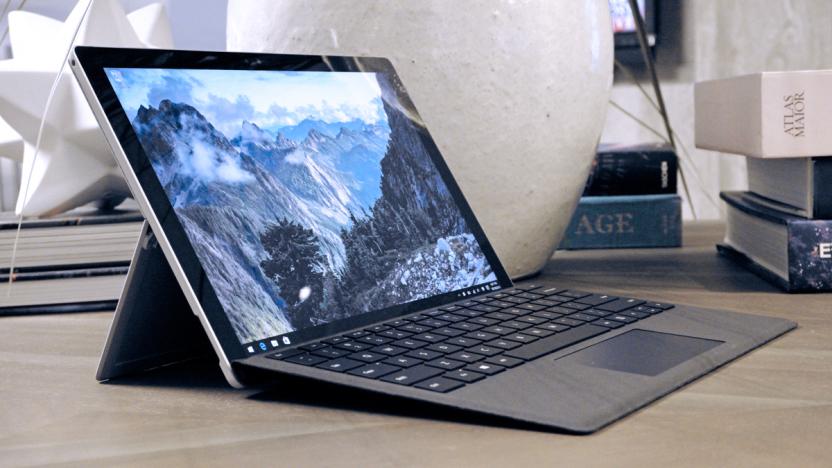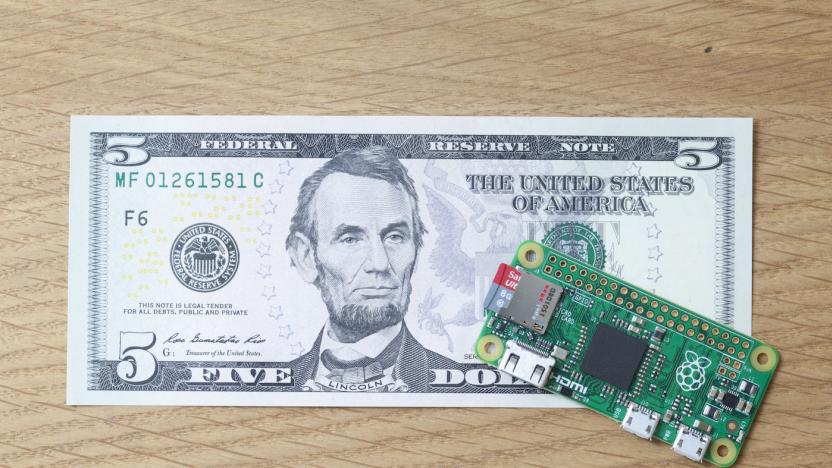computing
Latest

Living circuits can handle complex computing
Gene-based circuits are about to get decidedly more sophisticated. MIT scientists have developed a method for integrating both analog and digital computing into those circuits, turning living cells into complex computers. The centerpiece is a threshold sensor whose gene expression flips DNA, converting analog chemical data into binary output -- basically, complex data can trigger simple responses that match the language of regular computers.

Windows 10 won't let you share WiFi passwords any more
Remember Microsoft's WiFi Sense? One of its cornerstones is the ability to share password-protected WiFi networks with contacts, saving them the hassle of logging in when they visit. Unfortunately, though, there weren't many people enamored with the idea. Microsoft has pulled WiFi Sense's contact sharing in its latest Windows 10 Insider preview build after noting that it wasn't worth the effort given "low usage and low demand." It'll remain intact on slower Insider builds and regular Windows 10 releases for now, but it should disappear for everyone when the Anniversary Update hits in the summer.

Raspberry Pi's latest computer costs just $5
Over the years, the Raspberry Pi Foundation has enabled universities and hobbyists to create their own DIY computing projects with its affordable boards. But that doesn't mean it's stopping there. Today, the company unveiled its latest programmable computing board, the Raspberry Pi Zero, and it costs just $5 (£4). With its Broadcom BCM2835 application processor (1GHz ARM11 core), 512MB of RAM, a microSD card slot, a mini-HDMI socket supporting 1080p (at 60 frames per second), micro-USB sockets and an identical pin layout to its larger Pi siblings, the Zero can do plenty of heavy lifting, despite its tiny size. For context: at 65mm x 30mm, it's smaller than a credit card and has 40-percent faster chip than the first ever Pi.

IBM wires up 'neuromorphic' chips like a rodent's brain
IBM has been working with DARPA's Systems of Neuromorphic Adaptive Plastic Scalable Electronics (SyNAPSE) program since 2008 to develop computing systems that work less like conventional computers and more like the neurons inside your brain. After years of development, IBM has finally unveiled the system to the public as part of a three-week "boot camp" training session for academic and government researchers.

A water droplet computer is more useful than you think
Scientists have built a computer out of water droplets, but why? It's not the first computer we've seen built with analog materials, and obviously runs at a tiny fraction of an electronic circuit's speed. It turns out, however, that it could be very handy to have water droplets run preset programs, because they can simultaneously do tasks like transporting chemicals. That was the "aha" moment for Stanford University researcher Manu Prakash, a fluid mechanics major who has been thinking about a water-powered computer for the last ten years.

The law that predicts computing power turns 50
Today represents a historic milestone in technology: It's the 50th anniversary of Moore's Law, the observation that the complexity of computer chips tends to double at a regular rate. On April 19th, 1965, Fairchild's Gordon Moore (later to co-found Intel) published an article noting that the number of components in integrated circuits had not only doubled every year up to that point, but also would continue at that pace for at least a decade. He would later revise that guideline to every two years, but the concept of an unofficial law of progress stuck. It not only foresaw the rapid expansion of computing power, but also frequently served as a target -- effectively, it became a self-fulfilling prophecy.

Basics of quantum teleportation now fit on a single chip
Until now, quantum teleportation (that is, sending quantum data from one place to another) has required a room-filling machine. That's not going to usher in a brave new era of quantum computing, is it? However, a team of British and Japanese researchers has shrunk things down to a much more reasonable size. They've stuffed the core optical circuits for quantum teleportation into a single silicon chip that's just slightly longer than a penny -- in contrast, an experimental device from 2013 was nearly 14 feet long. While scientists built the chip using "state-of-the-art nano-fabrication," it should be more practical to make than its ancestors, which took months.

Light-bending silicon strips are the key to super-fast computers
No, that's not a barcode you're looking at -- instead, it's the likely future of computing. Stanford University researchers have developed an optical link that uses silicon strips to bend light at right angles, which future processors will likely need to transmit data at super-fast speeds. The key, as you might have gathered, is the series of gaps. When light hits the device, the combination of those gaps and silicon sends different wavelengths left and right. You're not limited to specific light bands or directions, either; you can use an algorithm to design the link you need within a matter of minutes.

Desktop-sized laser supercomputers could be coming by 2020
Small, eco-friendly optical supercomputers may soon be crunching quadrillions of calculations per second (exaflops) if a company called Optalysys has its way. It claims to be months away from demonstrating a prototype optical computer that will run at 346 gigaflops to start with -- not as fast as the best supercomputers, but pretty good for a proof-of-concept. Here's how it works: low-intensity lasers are beamed through layers of liquid crystal grids, which change the light intensity based on user inputted data. The resulting interference patterns can be used to solve mathematical equations and perform other tasks. By splitting the beam through multiple grids, the system can compute in parallel much more efficiently than standard multi-processing supercomputers (as shown in the charming Heinz Wolff-hosted video below).

Supercomputer passes the Turing test by mimicking a teenager (update: reasons to be cautious)
After 64 long years, it looks like a machine has finally passed the Turing test for artificial intelligence. A supercomputer in a chat-based challenge fooled 33 percent of judges into thinking that it was Eugene Goostman, a fictional 13 year old boy; that's just above the commonly accepted Turing test's 30 percent threshold. Developers Vladimir Veselov and Eugene Demchenko say that the key ingredients were both a plausible personality (a teen who thinks he knows more than he does) and a dialog system adept at handling more than direct questions.

Imprecise computers 'R' good enough for you, save power, yeah, yeah, yeah, yeah
You may have heard of probabilistic computing, a concept that relies on "good enough" calculations to save processing power. You may not know just why and where we should use it, however; thankfully, ExtremeTech has just offered an explanation of the technology's merits. The site notes that it's getting difficult to maintain accuracy and power efficiency as processors get ever more complex. By reducing precision in areas where it's not as essential, such as browsing and media playback, chip designers can significantly improve battery life. The technology isn't in widespread use just yet, but it may become commonplace in the near future. NXP is already making limited use of imprecise computing to improve security, while Intel has investigated variable-precision floating-point math units that scale back for less intensive tasks. While accurate processors are here to stay, there's a real chance they'll be accompanied by probabilistic circuitry in future energy-efficient gadgets.

Google celebrates the Manchester Baby and the birth of computer memory (video)
As part of its efforts to promote the unsung heroes of computing history, Google is celebrating the Manchester Baby's 65th birthday. Despite the cutesy nickname, the Manchester Small Scale Experimental Machine was the first computer to use electronic memory rather than punchcards for programming, heralding the software revolution. The secret was in the Williams-Kilburn cathode-ray tube, which could store a (then) staggering 128 bytes worth of data. Of course, that's not much by modern standards, but given that the 5-meter machine weighed in at over a ton, we still think it could take your fancy laptop in a bar-room brawl. If you're curious to learn more and hear the immortal quips of Professor F.C. Williams, head on past the break for the video.

CES 2013: PC and processor roundup
The most hyped tech news isn't always the most important. Having had a few days to dwell on what CES 2013 meant for computing, and for mobile computing in particular, we've settled on some less-than-obvious highlights. So, if you'd like to know how Intel stole the show but not our hearts; how Qualcomm's weird keynote was overshadowed by a late, secondary announcement from Samsung; and how some of the most exciting PC trends were mainly conspicuous by their absence, then please read on. It'll be like juice with bits, but only the bits that matter.

Researchers stumble onto 'lava' generated quantum dots, could power future peripherals
Have you ever been playing around with molten metal salt, when you accidentally created hollow, soft-shelled particles that could one day increase hard disk storage or power future QLED displays? Us neither, but that's exactly what happened to scientists at Rice University when they were researching "tetrapods" to make solar panels more efficient. Through an apparently wacky coincidence, they removed a single ingredient from the tetrapod stew, which left behind tiny droplets of cadmium nitrate. Selenium then melted around those drops, which completely dissolved away, leaving a melted selenium ball with a hole in the middle. It turns out that those selenium "doughnuts" can be packed tightly onto a metal surface without touching, thanks to their soft shells, which could allow more bits to be packed onto a hard drive, or be used in quantum computers and next-gen displays. Since the dots are smaller than a living cell, it took the researchers an entire year to figure out what they'd made and how they did it -- luckily they didn't just bin the whole thing and start over.

IBM Labs develops 'initial step' towards commercial fabrication of carbon nanotubes
Commercialization of carbon nanotubes is one of the holy grails of next-gen computing, and IBM thinks it's made crucial steps toward making this a reality. This isn't the first time that we've heard such a claim, of course, but IBM's considerable resources will make this particularly interesting. The specific problem it's been tackling is placing enough semiconducting nanotubes together to be useful in commercial chips, with current attempts being more in the hundreds, rather than billions that would be required. The new approach uses ion-exchange chemistry that allows controlled placement of nanotubes at two orders of magnitude greater than before, with a density of roughly a billion per square centimeter. To achieve this, the nanotubes are mixed with a soap-like substance that makes them water-soluble. Next, a substrate comprising two oxides and a hafnium oxide "trench" is immersed in the soap-solution, which results in the nanotubes attaching to the hafnium oxide canals with a chemical bond. Simple when you think about it! IBM hopes that as the materials and method are readily accessible now, that industry players will be able to experiment with nanotube technology at a much greater scale. Though, as we've become accustomed, there's no solid timescales on when this might realistically unfold.

Google's Turing doodle celebrates his genius, reminds us how dumb we are (video)
This week sees many corners of the globe celebrating the 100th anniversary of the birth of Alan Turing. A man whose contribution to the worlds of tech and gadgets is immeasurable -- a sentiment not lost on Google. Today, geeks and norms worldwide will be waking up to possibly the most complex doodle to date. Can you set the machine and spell out "Google"? If you can, you'll be sent off to lots more information about the man himself. This isn't the only thing Mountain View's done to keep his legacy alive, having previously helped Bletchley Park raise funds to purchase (and display) Turing's papers, and more recently helping curators at London's Science Museum with its Codebreaker - Alan Turing's Life and Legacy exhibition. If you haven't already, head to Google.com and pop your logic hat on, and if you get stuck, head past the break for a helpful video.

Microsoft details Windows 8's pre-boot world, helps you skip the F8 F8 F8 routine
Microsoft has been going into very exacting detail as to how Windows 8 works, but one area it hasn't explored much is what happens before you even see the Start screen. As user experience manager Chris Clark notes, the days of mashing F8 repeatedly to reach a pre-boot configuration are (mostly) over: you can invoke it either through an "advanced startup" in settings, through Start menu shortcuts or, if your PC is truly sick, let it show automatically. At least on systems blessed with UEFI instead of an aging BIOS, you'll get a lot more to tinker with as well, including going straight to the command prompt, recovering from a system image or booting from external storage. The emphasis on choosing your environment before you hit the power button is virtually necessary. A Windows 8 PC with a solid-state drive leaves just a 200-millisecond slice of time for any user input, and Microsoft would rather not have users caught in an infinite loop of restarting their systems as they unsuccessfully try to boot from USB drives. You'll likely discover the pre-boot space first-hand when the OS ships later this year, but for now you can check the source for more.

DICE to require 64-bit OS for some 2013 games, that Windows ME box in the den isn't cutting it
We're entering a world of mainstream 64-bit computing -- whether we like it or not. Just weeks after Adobe started requiring 64-bit Macs for CS6, DICE's Rendering Architect Johan Andersson has warned that some of his company's 2013 games using the Frostbite engine will need the extra bits as a matter of course. In other words, it won't matter if you have a quad Core i7 gaming PC of death should the software be inadequate; if you're still running a 32-bit copy of Windows 7 come the new year, you won't be playing. The developer points to memory as the main culprit, as going 64-bit guarantees full access to 4GB or more of RAM as well as better virtual addressing. Andersson sees it as a prime opportunity to upgrade to Windows 8, although 64-bit Vista and 7 (and presumably OS X, if and when Mac versions exist) will be dandy. Just be prepared to upgrade that Windows XP PC a lot sooner than Microsoft's 2014 support cutoff if you're planning to run the next Battlefield or Mirror's Edge.

Researchers say crab-based computing possible, lobsters throw up claws in disbelief
IBM's Holey Optochip? Yawn. Fujitsu's K supercomputer? Yesterday's news. Forget about boring old conventional computing stuff, the future of computer technology lies in crabs -- lots and lots of crabs. Researchers at Kobe University and the University of the West of England's Unconventional Computing Centre have discovered that properly herded crabs can signal the AND, OR and NOT arguments essential to computers, not to mention those crucial 1s and 0s. Forcing two swarms of crabs into one, for instance, represents the OR gate -- a trick the computational crustaceans pulled off fairly reliably. Not every operation was pincer perfect, however, as the crabs tended to stumble a bit through attempts at signaling the AND function. At least guiding a group of crabs isn't as tough as herding cats -- researchers used a shadow to imitate a predatory bird and direct the hapless creatures accordingly. Sure, it may not be the first biological computer, but it just might be the first fear-based computer.

Light-based 'Metatronics' chip melts minds, not copper
Engineers at the University of Pennsylvania have flipped the switch on a new type of computer circuit. Unlike conventional silicon, the new chip uses light -- not electricity -- to perform its logic. By creating an array of nano-rods, light-flow can be treated like voltage and current. These rods can then be configured to emulate electrical components such as resistors, inductors and capacitors. The benefits of the so-called "metatronic" system would be smaller, faster and more efficient computer chips, which is clearly a welcome prospect. Another curious property the team discovered, is what it calls "stereo-circuitry." Effectively one set of nano-rods can act as two different circuits, depending on the plane of the field. This means your CPU could become a GPU just by changing the signal. We can't speak for the light itself, but our minds are certainly bent.







